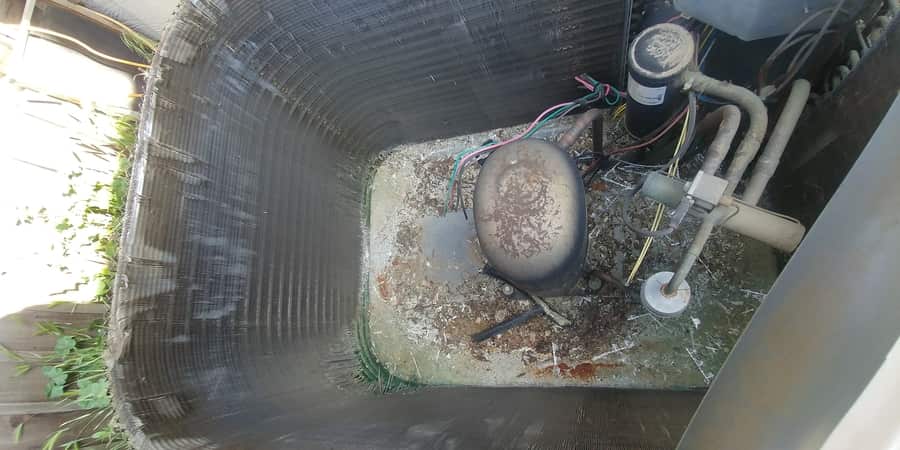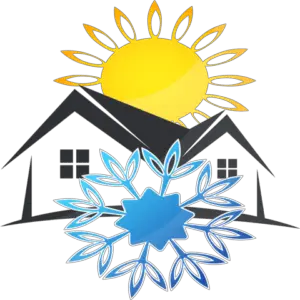So, yes. Too much ice can lead to problems. Freezing water or ice can exert force or pressure in all directions.
Not only will freezing water pipes burst from the pressure exerted by the ice inside the pipe, but ice on the outside of a copper pipe can crush the pipe in a heat pump coil.
An air to air heat pump needs air to flow through it’s coils to maintain a level of efficiency. Reasons for too much ice can be:
- wrong defrost timer setting
- defrost board or sensor problem
- plugged outdoor coil
- defective outdoor fan
- reversing valve problem
- low on refrigerant (Freon)
- unit not on risers
- snow and ice falling from the roof
The image above is an extreme case and rarely happens, but who’s to say when this damage begins. This was from a very old and often neglected heat pump.
Wrong Defrost Timer Setting
A heat pump has an automatic defrost system built into itself. A circuit board in the heat pump’s control panel has three set points for defrosting.
In my area of central Oregon where temperatures in the winter can stay below freezing for undetermined lengths of time we set our defrost timers to every 30 minutes. The other options are every 60 or 90 minutes.
Your particular setting would depend on your average weather. Some areas of the country would require no defrosting. Those areas are ideal for heat pumps and last longer because defrost cycles are strenuous for heat pumps.
Your heat pump circuit board also has a sensor that is placed at a strategically located spot on the return tubes of the outdoor coil. It will tell the circuit board to defrost if boards internal temperature setting is reached. That keeps the heat pump from defrosting unnecessarily.
Some boards also have an ambient sensing probe that can aid in determining the proper time and duration of a defrost cycle.
Can A Plugged Or Restricted Outdoor Coil Can Cause Ice Build Up?
Air flow is critical to a heat pump or any forced air system, for that matter. If an outdoor coil becomes restricted by any condition, it will cause icing in the winter and high head pressures in the summer.
Conditions obstructing airflow can be anything from smashed coil fins to cottonwood trees with fluffy seeds spreading for miles.
An epic hail storm hit our neck of the woods several years back. Golf ball size hail that ruined roofs, cars and air conditioners. I still see the damage on some of the commercial rooftop units. I don’t know how they function properly with the coil damage done by the hail. Maybe they don’t.
Is Icing A Symptom Of A Defective Outdoor Fan Motor?
You gotta move air or icing will occur. This is a problem that is, in most instances, fairly obvious.
Be aware that the outdoor fan motor should stop when a heat pump is in the defrost cycle, but restart when the cycle is over.
I’ve seen outdoor fan motors that run backwards and when running backward the fan pushes a lesser amount of air (in the wrong direction of course).
Capacitors fail and motor bearings go bad which is a straightforward diagnosis and repair. A capacitor failing is quite common, an easy fix, and shouldn’t be expensive.
Can Reversing Valve Problems Result In Ice On The Coil?
You could call the reversing valve the one thing that separates a heat pump from an air conditioner.

In the image above, you are looking down inside the heat pump. In the center is the compressor, and to the right is the reversing valve with three copper pipes sticking out of one side and one pipe out the other.
As a side note, look down to the lower left of the compressor and notice the corrosion and the missing fins on the coil—all resulting from constant icing and low refrigerant charge.
Back to reversing valves. They can stick, not allowing the correct refrigerant flow in the heat pump system, and icing can occur. Sticking in one position or the other will cause the heat pump to run in either heat or cooling mode.
The valve can even stick in between the two modes. If a reversing valve is stuck, it can be a very expensive repair, running into the plus side of a couple of grand. Reasons for these valves sticking is generally thought to be installation related, but parts can be defective also. Replacing the heat pump is a good option.
Will Low Freon Charge Cause A Heat Pump To Ice Up In Winter?
I wrote a pretty decent article about heat pumps icing up in winter. Very common problems that almost all heat pumps have at least once in there life time. If you want to read about some common ailments of heat pumps I wrote an article specific to that, you can read it HERE.
Low refrigerant charge will lead to icing of the outdoor coil in the winter and icing of the indoor coil in the summer.

Every Heat Pump Should Be Elevated To Allow Proper Drainage
At the bottom of every heat pump,stamped into the pan that supports the whole unit are drain holes. These holes will plug up and stop the moisture dripping off the coil in the defrost mode.
Ice will accumulate and build up into and around the coil and will begin that damage you’ve been reading about here.
With a properly operating defrost going on with system these drain holes need to be off the pad the unit sets on.
To keep heat pumps elevated we use a product call risers or pump ups.

If your heat pump sets directly on the pad or concrete patio or whatever, get it up a bit. You have to use extreme caution or know what you’re doing so you don’t create a leak when lifting the unit.
It’s nice when the refrigeration tubing coming from the house to the unit is a little long to allow some movement when the unit is lifted.
Get a professional to come lift it if necessary. It’s that important.
Pump ups are one of my recommended products. You can read more about them here and check some prices. They don’t cost much.
Snow And Ice Falling From The Roof Can Damage The Heat Pump
I had a customer who I bought and entire lid or top for his outdoor unit due to fall ice from his roof.
Even snow falling from the roof can add to the lack of air flow through the heat pump. It needs to be shoveled away.
You can build a roof over a heat pump, but you need to read the manufacturers specifications regarding obstructions and clearances.
Most of these can be found by searching installation instructions for you particular model number.
Again, I wrote an article that spell out a lot of the ins and outs of roofs over heat pumps. Please check it out.
Conclusion
Nothing can beat periodic maintenance for those products that we depend on almost every day. Heat pumps are no exception.
It’s surprising how many not so obvious problems can be caught early by a sharp technician.
I get the DIY mentality. I’m swimming in it. My dad lived through the depression. We built everything that could be built.
One night we built a wall in the shop, carried it out and attached it to the house in the dark of night so no body would notice a small addition to the house. In the morning, from the road, you would have thought it had always been there.
We built our own boat from a kit and spent many summers on Lake Billy Chinook and several other great places to water ski.
I fix nearly all my own stuff. It’s a way of life.

